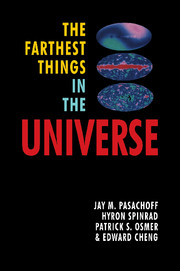CHAPTER THREE - Quasars
Published online by Cambridge University Press: 04 August 2010
Summary
Quasars, which can be a thousand times brighter than an ordinary galaxy, are the most distant objects observable in the Universe. How quasars produce the luminosity of 1013 suns in a volume the size of the solar system continues to be a major question in astronomy. Distant quasars are very rare objects whose study has been blocked by their scarcity. Recent technical advances, however, have opened new paths for their discovery. Forty quasars with redshifts greater than 4 have been found since 1986. Redshift 4 corresponds to a light travel time of more than 10 billion years. As a result, we are now able to probe the epoch shortly after the Big Bang when quasars may have first formed and to study the universe when it was less than a tenth its present age.
Quasars were one of the main discoveries thirty years ago that revolutionized astronomy. While they and the black holes thought to occur in their centers have become household words today, quasars are as enigmatic in many ways as they were when first discovered. Whatever their nature, they offer us views of the Universe never before seen, especially at distances far beyond what astronomers of the previous generation expected to see. In this chapter I wish to review briefly their history, how extraordinary their properties are, and how they serve as probes of the Universe to nearly as far as the visible horizon.
- Type
- Chapter
- Information
- The Farthest Things in the Universe , pp. 57 - 76Publisher: Cambridge University PressPrint publication year: 1994



